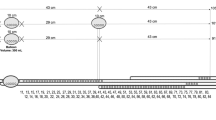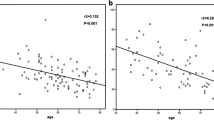Abstract
The contribution of the resting anal canal pressure (RAP) and the maximal squeeze pressure (MSP) to the problem of fecal incontinence was assessed by comparing 143 incontinent patients to a control population of 157 healthy subjects. These parameters were determined using a multilumen continuously perfused catheter and a mechanized rapid pull-through technique. In 10 male volunteers both RAP and MSP were determined using catheters that varied from 3 mm to 18 mm in diameter. In the control population, the RAP was significantly lower in females 40 years of age and over as compared to males. MSP values were significantly lower in females at virtually all ages. In women, parity did not correlate with RAP (coefficient=−0.099, P>0.05) and MSP (coefficient=−0.123, P>0.05) and any decrease in pressures was related to aging. Aging in women was associated with a consistent reduction in RAP (coefficient=−0.614, P<0.0005) and MSP (coefficient=−0.372, P=0.0006). In males, there was a similar but less impressive age-related reduction for the RAP (coefficient=−0.333, P=0.006) but not for the MSP (coefficient=−0.196, P>0.05). Nine percent of the volunteer population were essentially unable to increase the RAP with maximal squeeze efforts. A linear increase in anal pressures was recorded as catheter diameter increased from 3 to 12 mm. Normative data for the RAP and MSP (mean ±2sd) were constructed for each sex on a decade basis and showed a wide range of pressures for each age grouping. In the group with fecal incontinence (FI) 39% of females and 44% of males fell within the “normal” range for both the RAP and MSP. For all patients with FI, 41% and 17% had impairment of one or both parameters, respectively. It is concluded that: (1) aging affects the RAP in both sexes but to a greater degree in women. The MSP is related to aging in women only; (2) child bearing has no effect upon these parameters; (3) clinical problems of bowel control can occur when sphincter pressure measurements are within the low “normal” range; and (4) recording instrument diameter consistently affects RAP and MSP.
Similar content being viewed by others
References
Loening-Baucke V, Anuras S: Colonic motility and anorectal function in healthy elderly subjects. Gastroenterology 86:1165, 1984 (abstract)
Hancock BD: Measurement of anal pressure and motility. Gut 17:645–651, 1976
Schuster MM: The riddle of the sphincters. Gastroenterology 69:249–262, 1975
Hill JR, Kelly ML, Schlegal JF, Code CF: Pressure profile of the rectum and anus of healthy persons. Dis Colon Rectum 3:203–209, 1960
Matheson DM, Keighley MRB: Manometric evaluation of rectal prolapse and fecal incontinence. Gut 22:126–129, 1981
Taylor BM, Beart RW, Philips SF: Longitudinal and radial variations of pressure in the human anal canal. Gastroenterology 86:693–697, 1984
Bartolo DCC, Read NW, Jarratt JA, Read MG, Donnelly TC, Johnson AG: Differences in anal sphincter function and clinic presentation in patients with pelvic floor descent. Gastroenterology 85:68–75, 1983
McHugh SM, Diamant NE: Anal canal pressure profile by rapid pullthrough technique. Dig Dis Sci 29:550, 1984 (abstract)
Read NW, Haynes WG, Bartolo DCC, Hall J, Read MG, Donnelly TC, Johnson AG: Use of anorectal manometry during rectal infusion of saline to investigate sphincter function in incontinent patients. Gastroenterology 85:105–113, 1983
Frenckner B, Euler CV: Influence of pudendal block on the function of the anal sphincters. Gut 16:482–489, 1975
Gutierrez JG, Oliai A, Chey WY: Manometric profile of the internal anal sphincter in man. Gastroenterology 86:907, 1975 (abstract)
Duthie HL, Kwong NK, Brown NB: Adaptability of the anal canal to distension. Br J Surg 57:388, 1970 (abstract)
Buntine JA, Hughes ESR: The effect of extrinsic factors on intrarectal pressure. Aust NZ J Surg 34:218–221, 1965
Dickinson VA: Progress report —maintenance of anal continence: A review of pelvic floor physiology. Gut 19:1163–1174, 1978
Read NW, Bannister JJ: Anorectal manometry: techniques in health and anorectal disease.In Coloproctology and the Pelvic Floor. MM Henry, M Swash (eds). London, Butterworths, 1985, pp 65–87
Author information
Authors and Affiliations
Additional information
Supported through the Physicians Services Incorporated, the Toronto Western Hospital Foundation University of Toronto Dean's Fund, and the Elsie Watt Foundation
Rights and permissions
About this article
Cite this article
McHugh, S.M., Diamant, N.E. Effect of age, gender, and parity on anal canal pressures. Digest Dis Sci 32, 726–736 (1987). https://doi.org/10.1007/BF01296139
Received:
Revised:
Accepted:
Issue Date:
DOI: https://doi.org/10.1007/BF01296139




